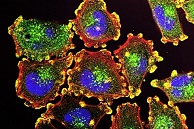DNA Damage Links to Onset of Skin Cancer, Melanoma Mapped
A critical link in mapping recurrent mutations of melanoma -- the most serious form of skin cancer in humans -- has been discovered by researchers.

One of the critical links in mapping recurrent mutations of melanoma -- the most serious form of skin cancer in humans -- has been discovered by researchers at Washington State University (WSU) School of Molecular Biosciences, in collaboration with researchers at Georgia State University.
In a paper, researchers established that DNA binding by a specific set of transcription factors, called ETS, is inherently mutagenic in UV-exposed cells. With new genome mapping technology, these findings provide a crucial understanding of mutations that result at ETS binding sites located in specific genes that are known to be drivers in the onset of melanoma in humans.
WSU researchers have developed a next-generation sequencing-based technology that allows them to precisely map the locations of UV-induced DNA damage throughout the whole human genome. Using this advanced technology, they generated a high-resolution UV damage map in human cells. By correlating the UV damage map with melanoma mutations, they discovered significantly elevated UV damage levels at ETS binding sites, which massively increased mutation rates at the same sites in sequenced melanoma genomes.
"UV-induced DNA damage is the major risk factor for melanoma, and DNA repair is a vital first line of defense against DNA damage to prevent mutations and cancer," stated Steven Roberts, assistant professor, WSU School of Molecular Biosciences, in WSU's College of Veterinary Medicine. "These pivotal results establish a fundamental research tool in cancer research and confirms we are on the correct course to further discovery by mapping UV damage in human cells."
Illustration: Metastatic melanoma cells. Photo courtesy of the National Institute of Health.
Read more...
Washington State University News Release (07/06/18)
Science Daily (07/06/18)
Abstract (Nature Communications, 2018; 9 (1).)
In a paper, researchers established that DNA binding by a specific set of transcription factors, called ETS, is inherently mutagenic in UV-exposed cells. With new genome mapping technology, these findings provide a crucial understanding of mutations that result at ETS binding sites located in specific genes that are known to be drivers in the onset of melanoma in humans.
WSU researchers have developed a next-generation sequencing-based technology that allows them to precisely map the locations of UV-induced DNA damage throughout the whole human genome. Using this advanced technology, they generated a high-resolution UV damage map in human cells. By correlating the UV damage map with melanoma mutations, they discovered significantly elevated UV damage levels at ETS binding sites, which massively increased mutation rates at the same sites in sequenced melanoma genomes.
"UV-induced DNA damage is the major risk factor for melanoma, and DNA repair is a vital first line of defense against DNA damage to prevent mutations and cancer," stated Steven Roberts, assistant professor, WSU School of Molecular Biosciences, in WSU's College of Veterinary Medicine. "These pivotal results establish a fundamental research tool in cancer research and confirms we are on the correct course to further discovery by mapping UV damage in human cells."
Illustration: Metastatic melanoma cells. Photo courtesy of the National Institute of Health.
Read more...
Washington State University News Release (07/06/18)
Science Daily (07/06/18)
Abstract (Nature Communications, 2018; 9 (1).)
